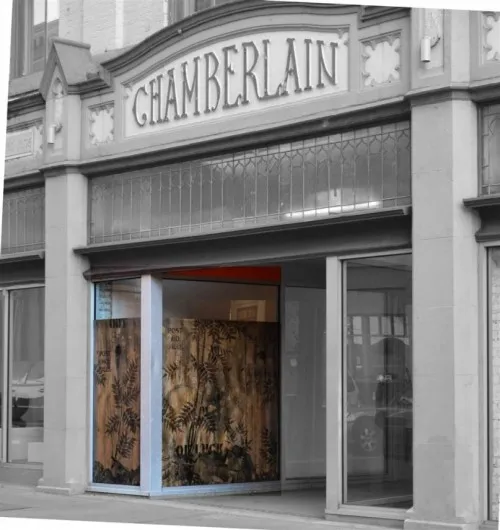Given and Taken

The former Chamberlain furniture factory, a 19th century building in historic downtown New Haven which now houses the Artspace gallery, is the reference point and the inspiration for “Given and Taken”, an installation I created in one of its windows. Part of the gallery’s group exhibition “Instructions not Included: Tinker, Hack, Tweak”, my project addresses the long-gone furniture makers who worked in the factory.

The factory building made me wonder what it would have been like to work there. Did the workers take pride in making the furniture or was the process just mechanical and repetitious? I wondered what the furniture was like that they made. Did the windows display sets of furniture for respectable rooms that the workers could aspire to? What were the ambitions and dreams that inspired and sustained their effort? What happened when the factory eventually closed? Was the building abandoned and forgotten? Did the unemployed workers move away? Were they pragmatic or did they sometimes walk by and try to look into the space where they once worked? I wondered what happened to their skills and experience and what happened to their dreams.
Although the building, a vestige of the confident economy of an earlier time, reminds me of how little I understand of the forces of capitalism and their message of transcendent consumerism, and although I sense my isolation from the experience of doing hard factory work, I decided to create a piece which remembers the workers of the factory by referencing the political and economic messages that possibly encouraged and motivated them: Manifest Destiny and the American Dream.

Both these ideas had obvious appeal. The 19th century doctrine of Manifest Destiny created a climate of exaggerated aspiration and optimism in the nation, as though its citizens were marked for greatness and entitled to exploit limitless natural resources. Later, while expansionist doctrines may have subsided, the American Dream with its patriotic and materialistic promise in return for hard work could still stoke unrealistic ambition. By the time the Chamberlain factory finally closed in the 1960’s the workers must have felt that implicit promises and dreams were withdrawn and the uplifting rhetoric silenced.
Fancying the spirits of the long-gone workers were still hovering around the building, I made a window display where they could catch sight of the dreams they might have once believed in. I covered the exterior of the window with plywood boards to mark the site as vacant and inaccessible. I stained and stencilled them with metaphors for abandoned aspirations: weeds, bubbles, and words.

I cut peep holes of different sizes and positions in the panels, inviting passersby to look in.


Perhaps their expectation would be that behind the boards they would see into the abandoned factory. Instead they glimpse two scenes, dreams that beckon, just out of reach. Each scene is painted in a box. One box presents a heroic landscape in the spirit of the Hudson River School, that group of idealistic American artists whose paintings glorified and propagated the concept of Manifest Destiny. This box suggests a diorama, a popular, theatrical form of entertainment at the turn of the century that commodified and made accessible the Romantic vision of nature.A tiny cabin within the bountiful landscape is, as I imagine it, the inspirational model for many who worked to expand the agricultural and industrial base of the nation.
The other box depicts a familiar icon of the American dream: a sofa. The sofa signifies social respectability and domestic comfort. In this small peep box it is a piece of factory-made furniture that crudely alludes to the refinements of earlier, more expensive, aristocratic styles. It implies the consumerist message that cultural hierarchies can be easily erased by purchasing a simulacrum of cultivated taste. However, the barren showroom, unnatural, anamorphic perspective and cold light suggest that sofa-purchasing is an illusionary goal, a disappointing compensation for toiling in the factory.

Manifest Destiny and the American Dream now feel like window display relics of a bygone era that disregarded responsibility for the land and glorified then forgot its factories and abandoned their workers. Why history had to unfold in this way is an imponderable mystery to me and probably to those hovering, pragmatic worker-spirits as well. “Instructions not Included” and the Chamberlain factory building brought this question to life for me, inspiring my installation: “Given and Taken”.